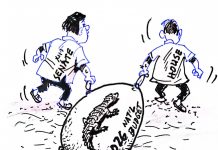
Local choreographers find this trend bothersome that local festivals are being choreographed by hired professionals from other regions, who bring in steps, props, and influences that don’t belong to our culture. This practice strips the festivals of their original essence, turning what should be authentic expressions of our heritage into performances with a foreign flavor. While some may argue that these changes enhance the spectacle, I believe they dilute the true cultural significance of these events.
When one attends a local festival, one expects to experience something deeply rooted in one’s traditions. The colors, dances, and rituals should reflect the history and stories of one’s ancestors. But with the increasing influence of choreographers from outside the community, we see more and more elements that feel alien to our own heritage. These choreographers may be talented, but they often introduce modern, flashy routines and props that feel disconnected from the festival’s original meaning. It’s disheartening to watch a festival that used to celebrate our roots morph into something that feels more like a generic, commercial production.
I understand that festivals evolve. But there’s a fine line between evolution and erosion. When choreographers bring in elements that are foreign to our culture, they risk erasing the very traditions the festivals are meant to preserve. We’ve seen this happen in our own locality, where once-familiar dances now include steps that are completely foreign to us. The result is a festival that looks impressive but feels hollow as if the soul of the event has been lost in favor of entertainment value.
One of the issues, I think, is that some local officials or organizers feel pressured to make the festivals more visually exciting to attract larger audiences, especially tourists. They believe that hiring professional choreographers will help achieve that. While we appreciate the effort to put our local events on the map, I feel like we’re losing sight of what matters: staying true to our culture. Festivals are not just performances; they are a celebration of our identity, and when we compromise that for spectacle, we lose something far more valuable.
We also wonder if the younger generation, growing up with these “new and improved” festivals, will even know what the original traditions looked like. When we were younger, we remember watching the elders lead the dances and rituals, and there was something sacred about it. Now, with these choreographed performances, we fear that future generations will have no memory of the authentic steps, songs, and traditions that were passed down through centuries.
Of course, I’m not saying we shouldn’t evolve or make our festivals appealing to a wider audience. But there has to be a balance. We can incorporate modern elements without losing the core of what makes the festival ours. The solution lies in involving local cultural experts or elders in the planning process. They can work with choreographers to ensure that the integrity of the festival is maintained, even as we look for ways to keep the event fresh and engaging.
We also need to educate ourselves and others about the importance of cultural preservation. It’s not enough to celebrate these festivals once a year; we need to understand the stories behind them and pass that knowledge down to the next generation. If we allow outsiders to define what our festivals should look like, we risk losing a crucial part of our identity.
While hiring outside choreographers may add flair to local festivals, we mustn’t lose sight of their original purpose. Our festivals are more than just entertainment—they are living expressions of our heritage. We should involve more local experts, prioritize authenticity over spectacle, and educate future generations about the importance of preserving our traditions. We need to ensure that our festivals remain true to their roots while still being relevant to today’s world.



